This article was co-authored by wikiHow Staff. Our trained team of editors and researchers validate articles for accuracy and comprehensiveness. wikiHow's Content Management Team carefully monitors the work from our editorial staff to ensure that each article is backed by trusted research and meets our high quality standards.
There are 11 references cited in this article, which can be found at the bottom of the page.
This article has been viewed 84,770 times.
Learn more...
It can be really frustrating to deal with a clogged syringe and regular cleaning doesn’t always help. If possible, throw used syringes away and use a new one each time. Reusing syringes can lead to infections.[1] However, if using a new syringe is not an option, you can try a few different ways of removing a clog. Once the clog is removed, sterilize it before using it again.
Steps
Using Hot Water to Unclog the Syringe
-
1Wear protective gloves for safety before handling the needles. Put on latex or latex-free sterile gloves to protect yourself from infection if you can. Even with gloves on, however, remain cautious when handling needles as these gloves will not protect you from a needle-stick.r[2]
- If gloves are not available, wash your hands thoroughly with soap and water before and after handling the syringe.
- If soap and water are not available, opt for an antibacterial hand lotion as an alternative.
-
2Detach the needle from the syringe with pliers. Hold the syringe in your non-dominant hand and face the needle away from you and others. Use pliers to grasp the needle and pull it off of the syringe.[3]
- Some syringes may have a screw-on attachment. If this is the case, use your pliers to unscrew the needle from the syringe.
Advertisement -
3Fill a large glass flask or jar with hot water. Choose a clean glass container that is large enough for you to submerge the entire needle. Fill the container with hot water from the tap. Place the needles in the hot water, pointy side down, and allow them to soak while running the hot water over them for 3-5 minutes.[4]
- If your tap water is not safe to drink, use boiled water instead.
-
4Reattach the needle to a clean syringe. Draw the syringe plunger out. Tightly hold the bottom of the needle between your fingers and insert it into the tip of the syringe.[5]
- If you have a screw-on syringe, twist the needle at its base to reattach it to the syringe.
-
5Blow air through the needle to remove any remaining residues. Hold the syringe between your fingers. Face the needle away from you and hold it over a napkin, towel, or sink. Push the plunger down to blow air through the needle. Draw the plunger out again and repeat this step several times until the plunger moves freely and easily.[6]
Using Heat to Melt the Clog in a Syringe
-
1Preheat an oven to 248 degrees F (120 degrees C). Use a lab oven or autoclave if you can. This equipment is the optimal size and shape for heating medical equipment like syringes.[7]
- If you are using a traditional kitchen oven, you will also need to use an oven safe container to house your syringes.
-
2Place the needle in the oven, upside down. In a lab oven, place a napkin on the bottom of the oven. Stand the needle, pointy side up, on the napkin. Lean it against the oven rack to help keep the needle standing.[8]
- In a traditional oven you may need to try different set-ups using your oven racks and an oven safe container to get the needles to stand vertically.
- Try placing the needle, pointy side up, inside a baking dish on the bottom rack. Allow the needles to rest against the bars of the top rack.
- The heat will melt any residue inside the syringe, so it’s important to stand the needle up so that the melted residue can flow out of the needle.
-
3Bake the needles for 10 minutes before removing. Remove the needles from the oven carefully and place them on a clean towel or in a sterilized jar. Use tongs or oven mitts to remove the needles as they will be hot to the touch.[9]
- The heat should have melted any residue that was stuck in the syringe.
-
4Flush the syringe with isopropyl alcohol to remove any remaining materials. You can buy rubbing alcohol at the grocery store or pharmacy in the first-aid section. Fill a small jar or glass with about 1 in (2.5 cm) of the alcohol. Insert the tip of the needle and draw back the syringe plunger to fill the syringe. Expel the solution into the sink by pushing the plunger down.[10]
- Avoid contact with your eyes and wear goggles for extra precaution.
- Avoid inhalation of the fumes from the isopropyl alcohol. Wear a vapor respirator or proceed in a well-ventilated area.
Community Q&A
-
QuestionHow do you get dried blood out of a syringe?
 Drew Hawkins1Community AnswerYou can unclog a syringe with dried blood in it by removing the syringe needle with a pair of pliers or by unscrewing it, filling a container that can hold the needle and syringe with hot water, and soaking them in the water for about 5 minutes. Then, remove the needle and syringe and reattach them, pull some of the water into the syringe through the needle and push it out by pressing on the plunger to force out any remaining pieces of the clog.
Drew Hawkins1Community AnswerYou can unclog a syringe with dried blood in it by removing the syringe needle with a pair of pliers or by unscrewing it, filling a container that can hold the needle and syringe with hot water, and soaking them in the water for about 5 minutes. Then, remove the needle and syringe and reattach them, pull some of the water into the syringe through the needle and push it out by pressing on the plunger to force out any remaining pieces of the clog. -
QuestionCan you use the same syringe twice on yourself?
 Drew Hawkins1Community AnswerNo, it's really unsanitary and unsafe to use the same syringe and needle on yourself twice. It can spread disease and potentially cause an infection. To be safe, discard both the needle and the syringe in an appropriate disposal container.
Drew Hawkins1Community AnswerNo, it's really unsanitary and unsafe to use the same syringe and needle on yourself twice. It can spread disease and potentially cause an infection. To be safe, discard both the needle and the syringe in an appropriate disposal container. -
QuestionHow do you remove a plunger from a syringe?
 Drew Hawkins1Community AnswerMost plungers on a syringe can be removed simply by pulling it all the way to the end, then pulling it out of the syringe with a swift tug. Some syringes have a plunger that needs to be rotated in order to be removed. Pull the plunger to the end of the syringe and rotate it to unscrew it to remove it.
Drew Hawkins1Community AnswerMost plungers on a syringe can be removed simply by pulling it all the way to the end, then pulling it out of the syringe with a swift tug. Some syringes have a plunger that needs to be rotated in order to be removed. Pull the plunger to the end of the syringe and rotate it to unscrew it to remove it.
Warnings
- Best practices in syringe use involves disposing of syringes in a sharps container after just one use.⧼thumbs_response⧽
Things You’ll Need
Using Hot Water to Unclog the Syringe
- Pliers
- Clean, hot tap water (or boiled water)
- Latex or latex-free gloves
- Hand soap or antibacterial hand lotion
- Glass flask or jar
Using Heat to Melt the Clog in a Syringe
- Autoclave or oven
- Oven-safe container (if using a traditional kitchen oven)
- Isopropyl (rubbing) alcohol
- Safety goggles
- Glass jar or dish
References
- ↑ https://www.thewellproject.org/hiv-information/cleaning-equipment-injecting-drugs
- ↑ https://www.ncbi.nlm.nih.gov/books/NBK138495/
- ↑ https://www.ncbi.nlm.nih.gov/books/NBK138488/
- ↑ https://youtu.be/NHZoxcozDjI?t=2
- ↑ https://youtu.be/NHZoxcozDjI?t=13
- ↑ https://youtu.be/NHZoxcozDjI?t=19
- ↑ https://youtu.be/NHZoxcozDjI?t=29
- ↑ https://youtu.be/NHZoxcozDjI?t=32
- ↑ https://youtu.be/NHZoxcozDjI?t=37



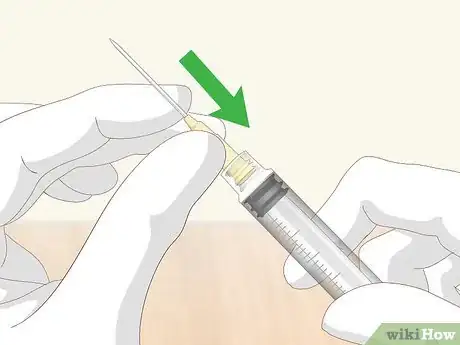


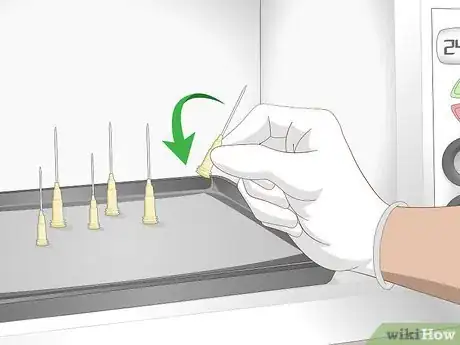
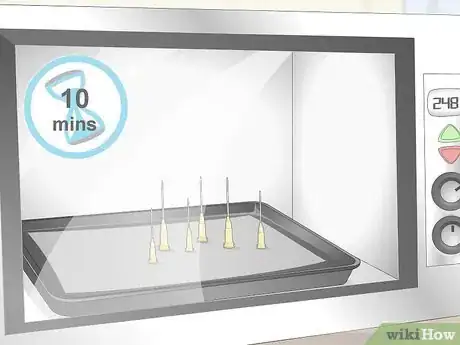
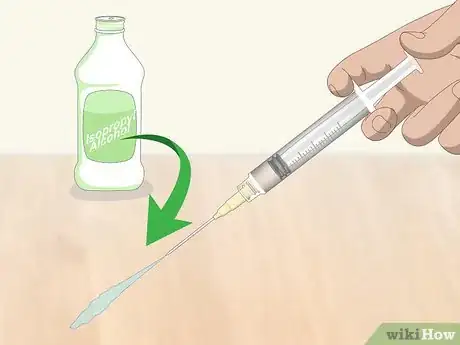
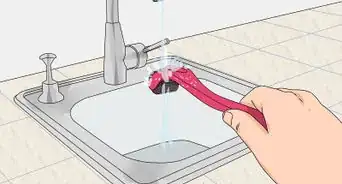



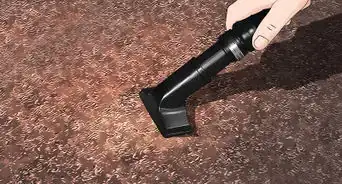

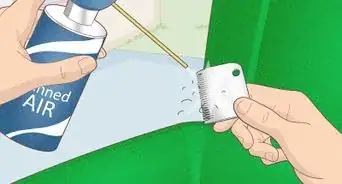
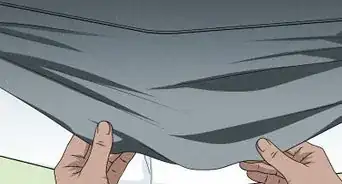
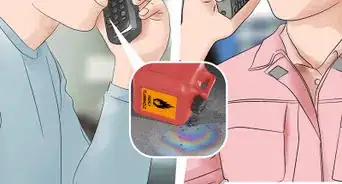







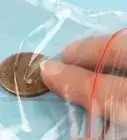
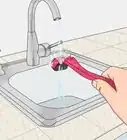





































Medical Disclaimer
The content of this article is not intended to be a substitute for professional medical advice, examination, diagnosis, or treatment. You should always contact your doctor or other qualified healthcare professional before starting, changing, or stopping any kind of health treatment.
Read More...